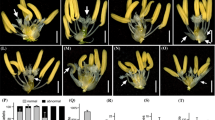Abstract
How floral organ number is specified is an interesting subject and has been intensively studied in Arabidopsis thaliana. In rice (Oryza sativa L.), mutations associated with floral organ number have been identified. In three mutants of rice, floral organ number 1 (fon1) and the two alleles, floral organ number 2-1 (fon2-1) and floral organ number 2-2 (fon2-2), the floral organs were increased in number centripetally. Lodicules, homologous to petals, were rarely affected, and stamens were frequently increased from six to seven or eight. Of all the floral organs the number of pistils was the most frequently increased. Among the mutants, fon1 showed a different spectrum of organ number from fon2 -1 and fon2 -2. Lodicules were the most frequently affected in fon1, but pistils of more than half of fon1 flowers were unaffected; in contrast, the pistils of most flowers were increased in fon2 -1 and fon2-2. Homeotic conversion of organ identity was also detected at a low frequency in ectopically formed lodicules and stamens. Lodicules and stamens were partially converted into anthers and stigmas, respectively. Concomitant with the increased number of floral organs, each mutant had an enlarged apical meristem. Although meristem size was comparable among the three mutants and wild type in the early phase of flower development, a significant difference became apparent after the lemma primordium had differentiated. In these mutants, the size of the shoot apical meristem in the embryo and in the vegetative phase was not affected, and no phenotypic abnormalities were detected. These results do not coincide with those for Arabidopsis in which clavatal affects the sizes of both shoot and floral meristems, leading to abnormal phyllotaxis, inflorescence fasciation and increased floral organs. Accordingly, it is considered that FON1 and FON2 function exclusively in the regulation of the floral meristem, not of the vegetative meristem.
Similar content being viewed by others
Abbreviations
- DIC:
-
differential interference contrast
References
Bowman JL, Smyth DR, Meyerowitz EM (1991) Genetic interactions among floral homeotic genes of Arabidopsis. Development 112: 1–20
Bowman JL (1994) Arabidopsis, an atlas of morphology and development. Springer-Verlag, New York, p 449
Clark SE, Running MP, Meyerowitz EM (1993) CLAVATA1, a regulator of meristem and flower development in Arabidopsis. Development 119: 397–418
Coen ES (1991) The role of homeotic genes in flower development and evolution. Annu Rev Plant Physiol Plant Mol Biol 42: 241–279
Coen ES, Meyerowitz EM (1991) The war of the whorls: genetic interactions controlling flower development. Nature 353: 31–37
Crone W, Lord EM (1993) Flower development in the organ number mutant Clavata1-1 of Arabidopsis thaliana. Am J Bot 80: 1419–1426
Goto K, Meyerowitz EM (1994) Function and regulation of the Arabidopsis floral homeotic gene PISTILLATA. Genes Dev 8: 1548–1560
Hernandez LF, Green PB (1993) Transductions for the expression of structural pattern: Analysis in sunflower. Plant Cell 5: 1725–1738
Herr JM, Jr (1982) An analysis of methods for permanently mounting ovules cleared in four-and-half type clearing fluids. Stain Technol 57: 161–169
Jack T, Brockman LL, Meyerowitz EM (1992) The homeotic gene APETALA3 of Arabidopsis thaliana encodes a MADS box and is expressed in petals and stamens. Cell 68: 683–697
Koornneef M, van Eden J, Hamhart CJ, Stann P, Braaksma FJ, Feenstra WJ (1983) Linkage map of Arabidopsis thaliana. J Hered 74: 265–272
Leyser HMO, Furner IJ (1992) Characterization of three apical meristem mutants of Arabidopsis thaliana. Development 116: 397–403
Librojo AL, Khush GS (1985) Chromosomal location of some mutant genes through the use of primary trisomies in rice. In: Rice genetics. IRRI, Manila, Philippines, pp 249–255
Mckelvie AD (1962) A list of mutant genes in Arabidopsis thaliana (L.) Heynh. Radiat Bot 1: 233–241
Medford JI, Behringer FJ, Callos JD, Feldmann KA (1992) Normal and abnormal development in the Arabidopsis vegetative shoot apex. Plant Cell 4: 631–643
Meyerowitz EM, Bowman JL, Brockman LL, Drews GL, Jack T, Sieburth LE, Wiegel D (1991) A genetic and molecular model for flower development in Arabidopsis thaliana. Development (Suppl. 1): 157–167
Okada K, Shimura Y (1994) Genetic analyses of signaling in flower development using Arabidopsis. Plant Mol Biol 26: 1357–1377
Roe JL, Rivin CJ, Sessions RA, Feldmann KA, Zambryski PC (1993) The Tousled gene in A. thaliana encodes a protein kinase homolog that is required for leaf and flower development. Cell 75: 939–950
Shannon S, Meeks-Wagner DR (1993) Genetic interactions that regulate inflorescence development in Arabidopsis. Plant Cell 5: 639–655
Sommer H, Beltran J, Huijser P, Pape H, Lonnig W-E, Saedler H, Schwarz-Sommer Z (1990) Deficiens, a homeotic gene involved in the control of flower morphogenesis in Antirrhinum majus: the protein shows homology to transcription factor. EMBO J 9: 605–613
Szymkowiak EJ, Sussex IM (1992) The internal meristem layer (L3) determines floral meristem size and carpel number in tomato periclinal chimeras. Plant Cell 4: 1089–1100
Takeoka Y, Mamun AA, Wada T, Kaufman PB (1992) Reproductive adaptation of rice to environmental stress. Elsevier, Amsterdam, p 226
Tamura Y, Kitano H, Satoh H, Nagato Y (1992) A gene profoundly affecting shoot organization in the early phase of rice development. Plant Sci 82: 91–99
Trobner W, Wolfgang T, Ramirez L, Motte P, Hue I, Huijser P, Lonnig W, Saedler H, Sommer H, Schwarz-Sommer Z (1992) GLOBOSA: a homeotic gene which interacts with DEFICIENS in the control of Antirrhinum floral organogenesis. EMBO J 11: 4693–4704
Weigel D, Meyerowitz EM (1994) The ABCs of floral homeotic genes. Cell 78: 203–209
Yanofsky MF, Ma H, Bowman JL, Drews GN, Feldmann KA, Meyerowitz EM (1990) The protein encoded by the Arabidopsis homeotic gene agamous resembles transcription factors. Nature 346: 35–39
Author information
Authors and Affiliations
Additional information
This work was supported in part by Grant-in-Aid for Scientific Research on Priority Areas from the Ministry of Education, Science and Culture of Japan.
Rights and permissions
About this article
Cite this article
Nagasawa, N., Miyoshi, M., Kitano, H. et al. Mutations associated with floral organ number in rice. Planta 198, 627–633 (1996). https://doi.org/10.1007/BF00262651
Received:
Accepted:
Published:
Issue Date:
DOI: https://doi.org/10.1007/BF00262651




